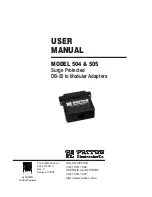
This listing shows which driver controls which device (controller). In the above example, the
interface information is shown highlighted
bold
. You can tell the information is for this interface
because the values shown for
Ctrl-17
and
18
are the controller handles for the interface 2
channels (from the information displayed by the
devtree
command).
NOTE:
The EFI driver’s handle values change on every boot.
TIP:
From the
drvcfg
command, record these two pieces of information for each channel
of each interface for parameters to be changed:
•
Drv
(the EFI driver’s handle)
•
Ctrl
(the controller’s handle)
4.
Using the information (the driver handle [
Drv
] and the controller’s handle [
Ctrl
]) from the
drvcfg
command, start the EFI Setup Utility for one channel of this interface.
At the EFI Shell prompt, enter:
drvcfg -s drvr_handle cntrl_handle
where
•
drvr_handle
is the handle of the driver that controls the channel whose ID you want
to display or change
•
cntrl_handle
is the handle of the controller for the channel whose ID you want to
display or change
Continuing the example for channel A of this interface, enter:
drvcfg -s 45 18
5.
The EFI Setup Utility starts and its main menu displays, showing a list of all the EFI capable
interfaces in the server.
TIP:
To move the cursor in the EFI Setup Utility, you can use these keys:
•
Arrow keys:
↑ ↓ ← →
•
Alternate keys:
H
= left
J
= down
K
= up
L
= right
I
= home
O
= end
Move the cursor to highlight the channel of the interface; and press
Enter
(to determine which
channel of the interface to highlight, match the
PCI Bus
,
PCI Dev
, and
PCI func
values
on this screen to the
Bus #
,
Dev #
, and
Fnc #
values from the
info io
command).
CAUTION:
Do
not
select the
<Global Properties>
option on the main menu.
6.
The Adapter Properties screen for this channel of the interface displays. Make sure the utility
is running for the channel of the interface by comparing the values shown for
PCI Bus
,
Specifying Parameters
167













































